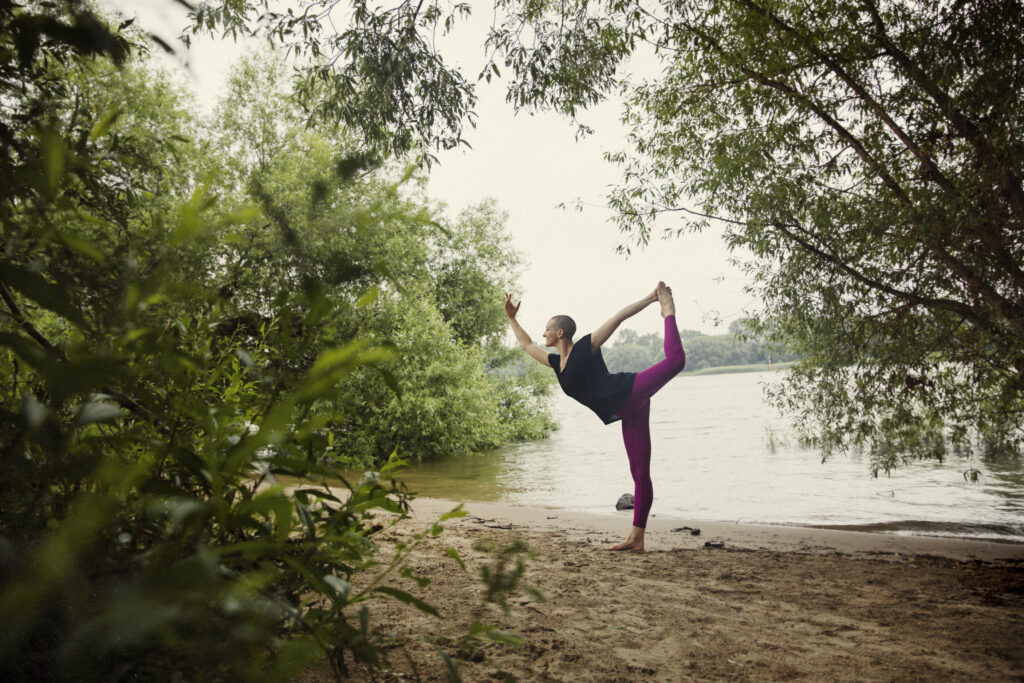 dancer pose on rhine river
dancer pose on rhine river
Natarajasana, often called Dancer Pose in English, or King Dancer Pose, is a celebrated and demanding yoga asana that encourages us to explore our bravery and empathy. Standing on the banks of the Rhine River in Cologne, Germany, striking the dancer pose embodies the spirit of this powerful posture.
The classical depiction of Shiva-as-Nataraj showcases him dancing on a dwarf, playing a drum. A cobra gracefully wraps around Shiva’s neck, his dreadlocks swirl dynamically, a ring of fire surrounds him, and a flame flickers in his palm.
Dancer Pose is characterized by standing on one leg, lifting the other leg behind, grasping the raised foot with the hand, and leaning forward while extending the opposite arm forward. This posture can be both challenging and deeply fulfilling. In this article, we will explore different modifications and variations to help you discover a Dancer Pose practice that unlocks its full potential.
Practice with Awareness
It’s crucial to approach any version of Dancer Pose with caution and mindful awareness. It is important to note that I am sharing personal experiences and insights from respected yoga experts, not as a medical professional. Always seek advice from a qualified healthcare provider for any health concerns and to determine if yoga practice is appropriate for you.
According to Mark Stephens in Teaching Yoga, potential physical risks associated with Natarajasana primarily involve the “Lower back, hamstrings and knee of the standing leg, shoulders if unstable or impinging.” (Teaching Yoga Location 4,091).
Always practice with a slow, deliberate pace, paying close attention to your body’s signals and respecting its limitations.
Step-by-Step Guide to Natarajasana
Jessamyn Stanley, in her book Every Body Yoga: Let Go of Fear, Get On the Mat, Love Your Body, explains that both supported and unsupported variations of Natarajasana are achievable. Stanley suggests using a prop for modification: “Optional Prop: 1 strap (make a loop with your strap that’s big enough to hold your foot)” (Every Body Yoga Location 1,092). If a yoga strap is unavailable, a long belt, dog leash, or towel can serve as a substitute. For balance assistance, practicing near a wall or sturdy chair or table is also beneficial.
Stanley’s detailed instructions for entering Dancer Pose are as follows:
- “Starting in Mountain Pose, place your right hand on your hip for balance and bend your left knee.
- Clasp the inside or outside of your left foot with your left hand and, using the power of your leg muscles, begin lifting your thigh.
- If using a strap, hold the strap in your left hand. With your right hand on your hip for balance, bend your left knee and place your foot into the strap. Hold the strap as close to your foot as you comfortably can.
- Keep squaring your hips forward and lifting your thigh away from the floor, actively flexing your foot into the hand or strap.
- Sweep your right arm forward and up, reaching through your fingers and still continuing to lift your thigh.
- Draw your standing thigh back and soften your heart forward. Stay for a few breaths, then switch sides.” (Every Body Yoga Location: 1,094-1,102)
Stanley provides valuable modifications and advice for numerous yoga poses. Regarding Dancer Pose, she offers further tips alongside visual aids illustrating the pose with and without a strap: “Keep your hips even and neutral,” “actively press your foot into your hand or strap,” “keep a bend in your standing knee if necessary,” “press your tailbone to the floor while actively lifting your pubic bone toward your navel,” and “if you are holding on to a strap, if you have the flexibility, rotate your shoulder so that your bent elbow points to the ceiling.”
Mark Stephens presents slightly different guidance in Teaching Yoga: Essential Foundations and Techniques: “From Tadasana, flex the right knee to draw the right foot up toward the right hip. Clasping the right foot with the right hand, rotate the right elbow in and up while extending the right leg back and up from the hip. Lift the left arm overhead, bend the left elbow, and clasp the right foot.” (Teaching Yoga Location 4,093-5).
Stephens emphasizes key points for both yoga instructors and practitioners: “Maintain pada bandha [connection of the sole of the foot to the floor] in the standing foot to stabilize the foot and ankle joint. Keep the standing leg straight and strong, avoiding locking the knee. Level the pelvis for a symmetrical foundation for spinal extension. Press the tailbone down, expand the chest, and press the lower shoulder blade tips forward and up to open the heart center. If stable and comfortable, release the crown of the head towards the foot’s arch and draw the elbows together. Breathe!” (Teaching Yoga Location 4,096-9).
Dancer Pose Variations and Modifications
Explore these variations and modifications of Dancer Pose in this accessible 35-minute yoga flow available on YouTube: Daring Dancer Pose Variations.
This video includes gentler Dancer variations, promoting balance on two points (one arm and one leg/knee), in side and twisted forms:
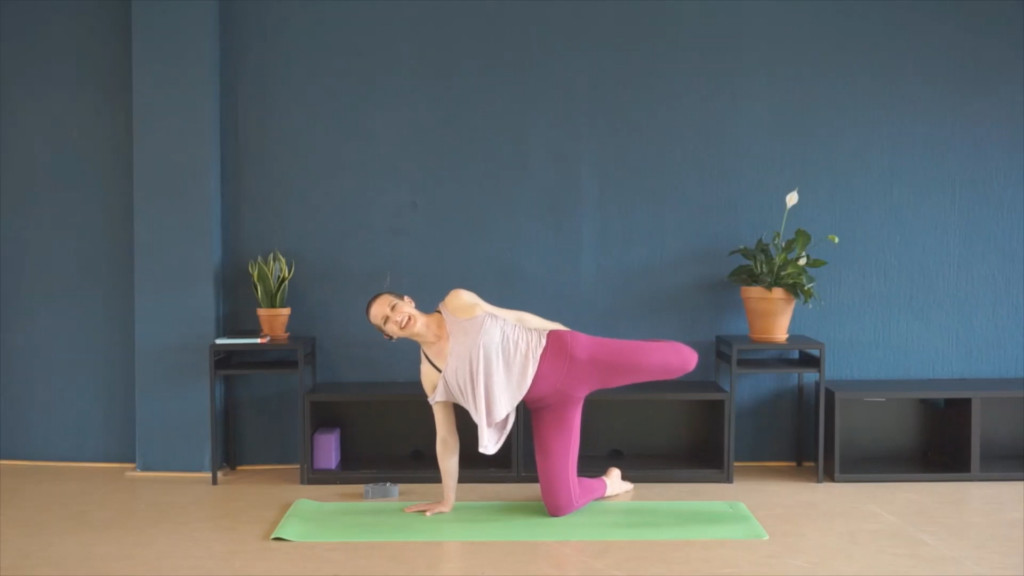 low side dancer pose variation
low side dancer pose variation
This variation, termed “Low Side Dancer,” offers a similar stretch and balance challenge to classic Natarajasana but from a different angle. A strap can also be incorporated.
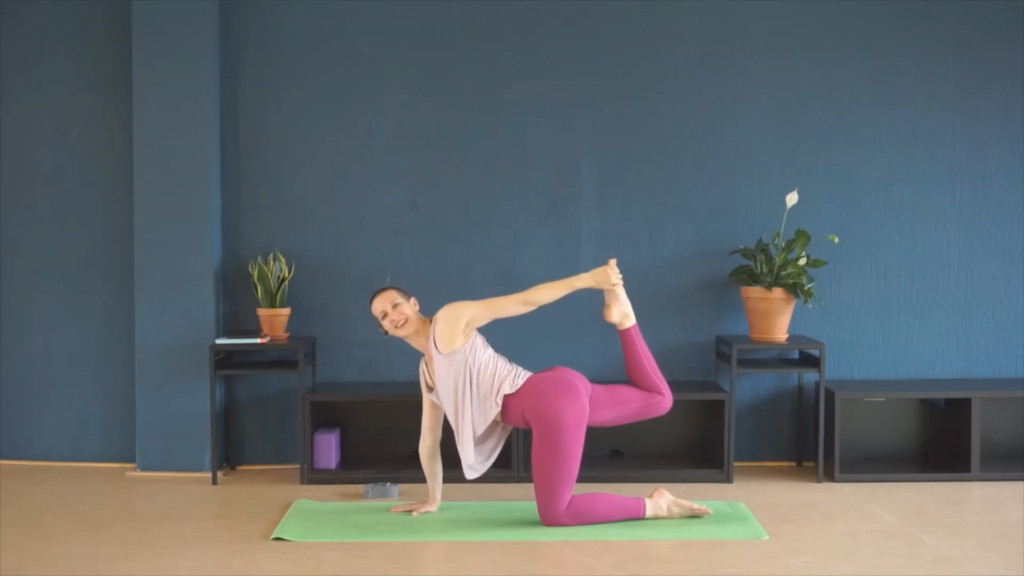 low twisted dancer pose variation
low twisted dancer pose variation
“Low Twisted Dancer” presents a slightly altered stretch and balance challenge compared to other variations, and is also adaptable with a strap.
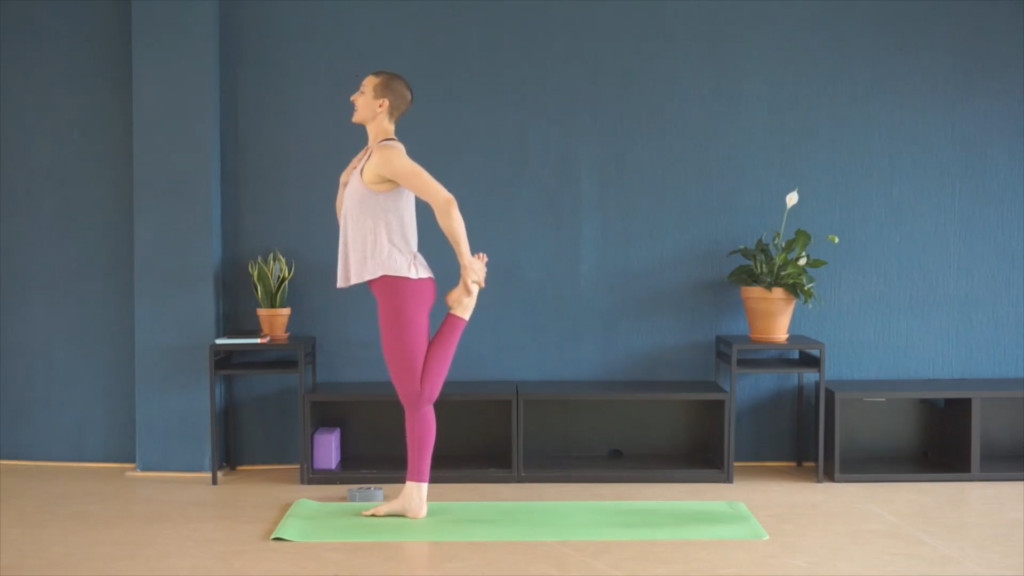 dancer pose hand heart quad variation
dancer pose hand heart quad variation
This posture can serve as a stepping stone to standing Dancer Pose or as a modification itself. It enhances one-legged balance, chest opening, stretching, and gentle backbending. A strap and/or wall can provide support.
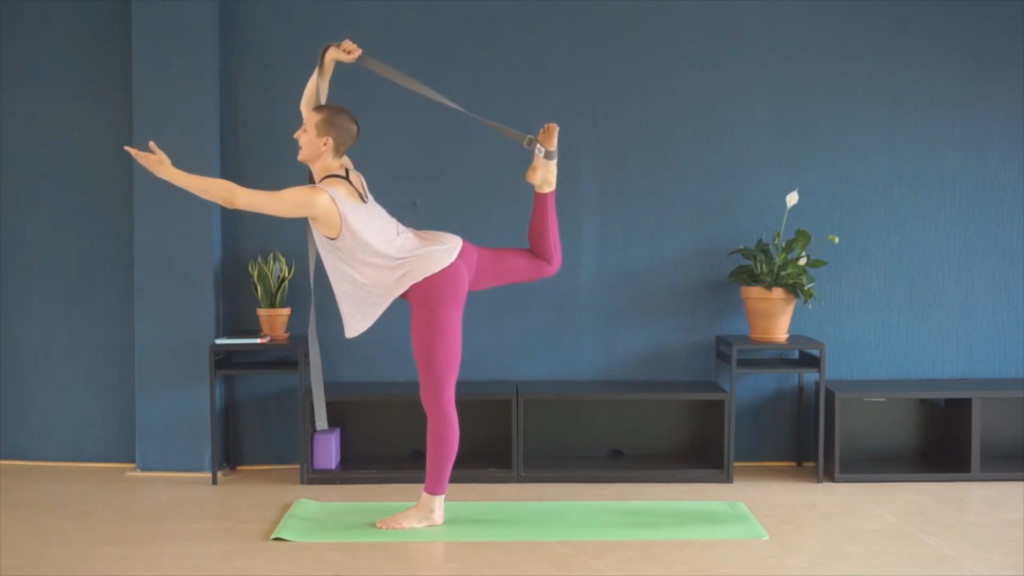 dancer pose with strap
dancer pose with strap
Practicing standing Dancer Pose with a Yoga Strap for support.
For added stability, position yourself in front of or alongside a wall. Consider your gaze and the shape of your forward-reaching hand. Various hand positions or mudras can be explored. The possibilities for variations and modifications are vast, enabling you to personalize your Dancer Pose practice.
The Mythology of Natarajasana
Reflecting on the origins and potential benefits of Dancer Pose can be inspiring when tackling this demanding asana. In Myths of the Asanas: The Stories at the Heart of the Yoga Tradition, Alanna Kaivalya, Shiva Rea, and Manorama explain Nataraj as a representation of Shiva in his role as the Master Dancer, the destroyer of cycles, eternally dancing to his drumbeat, creating space for Brahma to initiate creation anew.
Key aspects of this narrative to emphasize include Shiva as King Dancer, the Cycle of Samsara, and the Illusion of Avidya. Kaivalya and Rea state, “As one of the Hindu trinity, Shiva has many different personae that illuminate his essence. The most well known is his role as the King Dancer, or in Sanskrit, Nataraja. In this guise he is commonly portrayed with snakes around his neck, dreadlocks standing on end, balancing atop a tiny dwarf, and encircled by a ring of fire.” (Myths of the Asanas Location: 537-539).
The ring of fire surrounding Nataraj symbolizes samsara. Kaivalya and Rea clarify, “Shiva dances to his own music within a circle of flame known as samsara. Samsara is the cyclical pattern in which we are all stuck—the constant repetition of birth, life, and death.” (Myths of the Asanas Location: 544-5).
The cobras coiled around Nataraj’s neck add another layer of symbolism: “The poison the cobra carries symbolizes the toxic nature of avidya, the misunderstanding of ourselves as something other than divine. He has found the remedy to that affliction, which is enlightened knowledge, and he carries its symbolic flame in one of his palms.” (Myths of the Asanas Location: 550-1 emphasis mine).
Lessons from Dancing Pose Yoga
What can we learn from Dancer Pose, both as dancers and as individuals?
Kaivalya and Rea provide insights into how the physical challenges of Dancer Pose connect with our psychological boundaries: “Natarajasana allows us to experience a couple of physical elements that can bring about fear in our bodies. Backbending and balancing both elicit fear because of the openness and bravery they require. We tend to store fear in our heart (according to the chakra system), and when we open the heart, we give ourselves an opportunity to let go of fear. Likewise, balancing gives us an opportunity to overcome our natural fear of falling and to be brave and free.” (Myths of the Asanas Location: 576-8).
This yoga pose uniquely combines balancing and backbending, both elements that can evoke fear. Yoga practices often address these skills separately, gradually expanding comfort zones. We enhance stability, balance, and flexibility in crucial muscle groups (hips, back, shoulders). Practices include balancing on one leg (e.g., tree pose), on arms (e.g., crow, handstand), and backbends in different orientations (e.g., camel, bow, wheel).
It’s a misconception that dancers possess innate flexibility and ease in Dancer Pose. It presents unique challenges for everyone. Personally, decreased lower back flexibility requires mindful preparation and practice for Dancer Pose. The fear of balancing and backbending is universal. Everyone encounters a personal mix of challenges and strengths, navigated through consistent yoga practice.
Dancers and athletes can gain both physical and mental benefits from Dancer Pose. The courage displayed by students attempting Dancer for the first time is truly inspiring, given its internal and external demands.
Both Nataraj’s myth and the practice of the pose teach us to confront fears, embrace change, release attachments, and ultimately liberate and embrace our true nature and the universe’s.
Spiritual Advantages of Dancer Pose Practice
On a spiritual level, practicing Dancer and other challenging poses introduces us to avidya and a related concept, abhinivesha. Kaivalya and Rea explain: “In the Yoga Sutra, Patanjali outlines five obstacles that prevent us from true freedom, which are called the kleshas. The first is avidya, and the fifth and most powerful obstacle is the fear of death, or abhinivesha. Death is the ultimate change and takes many forms in our lives, until the greatest death of all, which comes at the end. As the lord of death and destruction, Shiva understands that change, even one as great as death, is really the only constant in the universe.” (Myths of the Asanas Location: 566-7).
Navigating change is a vital life skill that yoga cultivates. This process is significantly enhanced by self-awareness and self-knowledge, nurtured through compassionate self-study via reflective practice and meditation. Dianne Bondy and Kat Heagberg, in Yoga Where You Are, dedicate a chapter to these practices, stating that “Compassionate self-study offers a path to meet yourself without judgement, just where you are and just how you are.” (p.212).
Compassionate self-study occurs during meditation and journaling, but also during mindful yoga practice. For further exploration of written reflection, refer to “Reflective Practice through Journaling in Dance, Yoga & Life,” or for meditation practice guidance, see the “2021 Meditation Practice Challenge blog.”
Our ultimate goal is greater freedom: freedom of movement, courage to face the unknown, and compassion for ourselves and others.
“In order to dance like Shiva, we must feel free. Freedom comes from knowing there is nothing that binds us permanently. Shiva’s dance is born out of a liberation from the fear of change. He teaches us to ride the wave of change as if we’re on a cosmic surfboard, coasting toward the shore of bliss.” (Myths of the Asanas Location: 564-5).
Reflection Prompts
- What challenges do you encounter while practicing Dancing Pose Yoga?
- Which modifications or variations assist you in accessing the pose?
- Which yoga poses or movements generally present the greatest difficulty for you?
- What emotions arise during these challenging moments?
- How can modifications or variations help you realize the potential benefits of these poses, movements, or activities?
- How can I or another trusted instructor support your practice further?
Blythe Stephens, MFA & Bliss Catalystshe/her or they/themA Blythe Coach: Dance Education & Coaching move through life with balance, grace, & power
DISCLAIMER: A Blythe Coach recommends consulting your physician regarding the suitability of any recommendations and adhering to all safety guidelines before starting any exercise program. Participation in any exercise or exercise program carries the risk of physical injury. By engaging in this exercise or exercise program, you acknowledge that you are doing so at your own risk, voluntarily participating in these activities, and assuming all risks of injury.

